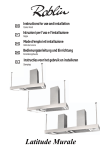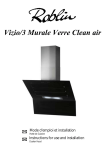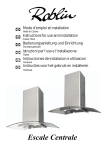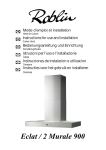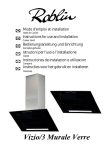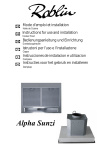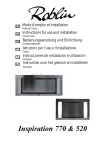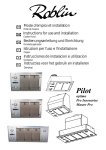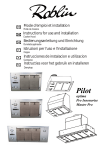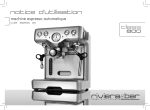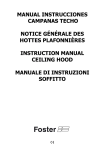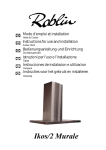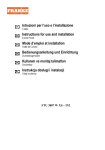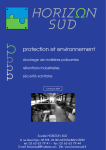Download Latitude Centrale
Transcript
GB IT FR DE NL Instructions for use and installation Cooker Hood Istruzioni per l’uso e l’installazione Cappa Mode d’emploi et installazione Hotte de Cuisine Bedienungsanleitung und Einrichtung Dunstabzugshaube Instructies voor het gebruik en installeren Dampkap Latitude Centrale (# Instructions Manual INDEX RECOMMENDATIONS AND SUGGESTIONS .....................................................................................................................2 CHARACTERISTICS .............................................................................................................................................................3 INSTALLATION......................................................................................................................................................................4 USE ........................................................................................................................................................................................8 MAINTENANCE .....................................................................................................................................................................9 *5 Libretto di Istruzioni INDICE CONSIGLI E SUGGERIMENTI............................................................................................................................................12 CARATTERISTICHE............................................................................................................................................................13 INSTALLAZIONE .................................................................................................................................................................14 USO......................................................................................................................................................................................18 MANUTENZIONE ................................................................................................................................................................19 '3 Manuel d’Instructions SOMMAIRE CONSEILS ET SUGGESTIONS..........................................................................................................................................22 CARACTERISTIQUES.........................................................................................................................................................23 INSTALLATION....................................................................................................................................................................24 UTILISATION .......................................................................................................................................................................28 ENTRETIEN.........................................................................................................................................................................29 %& Bedienungsanleitung INHALTSVERZEICHNIS EMPFEHLUNGEN UND HINWEISE ...................................................................................................................................32 CHARAKTERISTIKEN .........................................................................................................................................................33 MONTAGE ...........................................................................................................................................................................34 BEDIENUNG........................................................................................................................................................................38 WARTUNG...........................................................................................................................................................................39 NL Gebruiksaanwijzing INHOUDSOPGAVE ADVIEZEN EN SUGGESTIES.............................................................................................................................................42 EIGENSCHAPPEN...............................................................................................................................................................43 INSTALLATIE.......................................................................................................................................................................44 GEBRUIK .............................................................................................................................................................................48 ONDERHOUD......................................................................................................................................................................49 EN 2 1 RECOMMENDATIONS AND SUGGESTIONS The Instructions for Use apply to several versions of this appliance. Accordingly, you may find descriptions of individual features that do not apply to your specific appliance. INSTALLATION • The manufacturer will not be held liable for any damages resulting from incorrect or improper installation. • The minimum safety distance between the cooker top and the extractor hood is 650 mm. • Check that the mains voltage corresponds to that indicated on the rating plate fixed to the inside of the hood. • For Class I appliances, check that the domestic power supply guarantees adequate earthing. Connect the extractor to the exhaust flue through a pipe of minimum diameter 120 mm. The route of the flue must be as short as possible. • Do not connect the extractor hood to exhaust ducts carrying combustion fumes (boilers, fireplaces, etc.). • If the extractor is used in conjunction with non-electrical appliances (e.g. gas burning appliances), a sufficient degree of aeration must be guaranteed in the room in order to prevent the backflow of exhaust gas. The kitchen must have an opening communicating directly with the open air in order to guarantee the entry of clean air. USE • The extractor hood has been designed exclusively for domestic use to eliminate kitchen smells. • Never use the hood for purposes other than for which it has been designed. • Never leave high naked flames under the hood when it is in operation. • Adjust the flame intensity to direct it onto the bottom of the pan only; making sure that it does not engulf the sides. • Deep fat fryers must be continuously monitored during use: overheated oil can burst into flames. • Do not flambé under the range hood; risk of fire • This appliance is not intended for use by persons (including children) with reduced physical, sensory or mental capabilities, or lack of experience and knowledge, unless they have been given supervision or instruction concerning use of the appliance by a person responsible for their safety. • Children should be supervised to ensure that they do not play with the appliance. 650 mm min. MAINTENANCE • Switch off or unplug the appliance from the mains supply before carrying out any maintenance work. • Clean and/or replace the Filters after the specified time period. • Clean the hood using a damp cloth and a neutral liquid detergent. • This appliance complies with European regulations on low voltages Directive 2006/95/CE on electrical safety, and with the following European regulations: Directive 2004/108/CE on electromagnetic compatibility and Directive 93/68 on EC marking. is attached to a product it means the product is covered by the European When this crossed-out wheeled bin symbol directive 2002/96/EC.Your product is designed and manufactured with high quality materials and components, which can be recycled and reused.Please inform yourself about the local separate collection system for electrical and electronic product. Please act according to your local rules and do not dispose of your old products with your normal household waste. The correct disposal of your old product will help prevent potential negative consequences for the environment and human health. EN 2 CHARACTERISTICS Dimensions AVANT HOTTE (COTE CDE) AVANT HOTTE (COTE CDE) 1006.75 408.25 37 9 10 220 301.5 645 180 37 343.5 10 10 131 343.5 220 645 5 5 926.4 10 301.5 9 0.2 926.4 0.2 210 926.4 5 210 37 5 926.4 9 0.2 180 131 1500 0.2 9 37 1415 1415 1800 AVANT HOTTE (COTE CDE) AVANT HOTTE (COTE CDE) 1156.75 558.25 500 1073 1073 343.5 220 301.5 210 10 301.5 220 645 131 343.5 10 180 .59 500 645 10 10 1073 180 131 .59 210 500 .59 1073 .59 500 1715 1715 2200 AVANT HOTTE (COTE CDE) 544 .89 544 .89 10 131 220 301.5 645 343.5 10 180 210 544 .89 .89 544 606.75 901.5 606.75 2115 EN 8 3 INSTALLATION ATTENTION: Do not forget to use adequate plugs to the support brackets. Enquire after the manufacturers. Do an embedding if necessary. The manufacturer accepts no responsibility in case of a faulty hanging due to the drilling and the setting up of plugs in the ceiling. Fig. 1 Fig. 3 X - 85 mm 210 180 131 343.5 FRONT ( Control Panel) X = 1500 - 1800 - 2200 mm 89 301.5 Y 180 210 REAR Fig. 2 • LAYING OUT BEFORE FITTING THE HOOD 1) Mark the centre of the cooking appliance onto the ceiling with a plumb line. Draw the horizontal axes running parallel to the stove top onto the ceiling and as illustrated Fig. 1 & 2 mark the positions on the ceiling for : - The 4 for Ø 10 mm nuts and bolts. - The cut-out Ø 170 mm for the ducting Ø 150 mm in the extraction mode when ducting runs through the ceiling and for the 3-core mains cable. - The 4 hole centres of the chimney bracket item D. 2) Drill the different holes with the appropriate masonry bit. EN 4 • FITTING THE HOOD 3) Fitting the telescopic pins (Fig. 8): a) When fixing the telescopic pins to a plasterboard ceiling ensure it is reinforced as illustrated in Fig. 3 and attach using 4 Ø10mm nuts and bolts ensuring the bolts as sleeved between the plasterboard and the joist supports to prevent the ceiling being damaged when the bolts are tightened up. If the ceiling is concrete, use Ø 10 mm steel rawl bolts or anchors plugs with external threads (Not provided). Plastic rawl plugs must not be used. b) Screw the nuts onto the Ø 10 mm rod exceeding the ceiling, the welding washers upon as illustrated Fig. 4a. c) Slide the tubes item O around the tubes with the rod (Fig. 4b). d) Unscrew the lock nuts (Fig 4c) and expand the rods to the require length. e) Place the second washers, screw the upper tubes onto the Ø 10 mm rod exceeding the ceiling and then tighten the upper tubes giving a quarter turn by hand. Adjust the lenght of the rods ensuring the canopy aligns horizontally and vertically with the cooking appliance Fig. 4e and then tighten the lock nuts with moderation. 4)Fix the chimney bracket item D onto the ceiling using the 4 fixing holes Ø 12 mm (Fig. 3). 5) Place the hood under the pins item O for hanging the canopy to the ceiling . Attention: 3 persons are necessary to secure this operation. The bracket D of the chimney is not a carrying element, only the 4 telescopic pins. Fig. 4a Fig. 4b Fig 4c 6) Fix the telescopic pins to the corners of the canopy with the washer 5 holes with the 4 screws as illustrated Fig. 4f. 7) Finish by expanding the upper tubes slightly around the rods to the bottom Fig. 4g. 8) Check the vertical and parallelism of the chimney and the canopy Fig. 4g Fig. 4f. Fig. 4e EC EL HE 2L 1 / EN 51 1 • DUCTING IN THE EXTRACTION MODE: The hood is more effective when used in the extraction mode (ducted to the outside). When the cooker hood is ducted to the outside, charcoal filters are not required. The ducting used must be 150 mm (6 INS), rigid circular pipe and must be manufactured from fire retard-ant material, produced to BS.476 or DIN 4102-B1. Wherever possible utilise rigid circular pipe which has a smooth interior, rather than the expanding concertina type ducting. Maximum length of ducting run: - 4 metres with 1 x 90° bend. - 3 metres with 2 x 90° bends. - 2 metres with 3 x 90° bends. The above assumes our 150 mm (6 INS) ducting is being installed. Please note ducting components and ducting kits are optional accessories and have to be ordered, they are not automatically supplied with the chimney hood. 9) Fit the noise-reduction tube item I over the round outlet item 6 on top of the canopy while pressing down until they snap into position, place the non-return backflow flaps item J and secure the connections with appropriate clamping rings or adhesive tape (Fig. 6 ). 10) Connect the ducting 150mm (6 INS) and secure the connections with appropriate clamping rings or adhesive tape (Fig. 6). J 6 11) Before fitting the chimney to the canopy make the electrical connection as described in the section titled ELECTRICAL. • Connect the hood to the mains through a two-pole switch having a contact gap of at least 3 mm. • Remove the grease filters (see paragraph Maintenance) being sure that the connector of the feeding cable is correctly inserted in the socket placed on the side of the fan. • Join the connectors. • Install the odour filter and the charcoal filter in case the hood is to be used in recycling version. • Install the grease filter again. EN 6 • Ducting in the recirculation mode 12) Fit the recirculation spigot R onto the chimney bracket. 13) Connect the ducting 150mm (6 INS) not provided between motors item 6 and the recirculation spigot and secure the connections with appropriate clamping rings or adhesive tape (Fig. 6). 14) Insert the charcoal filter into the base of the motor housing and secure the filter with two securing straps A as illustrated Fig. 6. Fig. 6 A • Fitting the Chim ney 15) Place the Top chimney with the slots facing upwards when installing the recirculation version, or vice versa with the slots facing downwards when installing the ducting version, then fix the top part to the Upper Chimney Connector using the screws 12c provided. 16) Place the lower chimney. EN 7 USE A B C E D F G H Control panel Button A B C D E Function Display Turns the suction motor on and off at the last Displays the speed set speed used. Decrease the working speed. Increase the working speed. Activates intensive speed from any other speed even with the motor off. This speed is timed to run for 10 minutes, after which the system returns to the previous speed. Suitable to deal with maximum cooking fumes. Activates the motor at a speed that allows extraction of 100 m3/h for 10 minutes every hour, after which the motor stops. When the filter alarm is on, press the button for approximately 3 seconds to reset the alarm. These indications are only visible when the motor is turned off. F Activates automatic shutdown after 30’. Suitable to complete elimination of residual odours. Can be activated from any position, and is turned off by pressing the button or switching the motor off. G Turns the main lighting system on and off. H Turns the ambiance lighting system on and off. EN Displays HI and the bottom right hand spot flashes once a second. Displays 24 and the bottom right hand spot flashes, while the motor is turned on On completing the procedure the previous indicator is turned off: FF indicates that the metal grease filters need washing. The alarm is triggered after the Hood has been in operation for 100 hours. EF indicates that the activated charcoal filter needs changing and the metal grease filters need washing. The alarm is triggered after the Hood has been in operation for 200 hours. Alternately displays the working speed and the time remaining before the hood turns off. The bottom right hand spot flashes. 8 MAINTENANCE Metal grease ÿlte rs Filters can be washed in the dish machine. They need to be washed when FF-sign appears on the display or in any case every 2 months, or even more frequently in case of particularly intensive use of the hood. Alarm reset • Switch off the hood and the lights. If the 24h-function has been activated this has to be deactivated. • Press the E-key till the display is unlit. Cleaning the filters • Unhook filters one by one. supporting the filters with one hand, act on the knob (pull and rotate) and then take off the security spring. • Wash the filters, taking care not to bend them. Allow them to dry before refitting. • Reassemble the filters, paying attention on replacing the security spring. 1500 (x 3) 1800 (x 4) 2200 (x 6) EN 9 Charcoal filter (recycling version) • This filter cannot be washed or regenerated. It must be replaced when the EF appears on the display or at least once every 4 months. Activation of the alarm signal • In the recycling version hoods the filter saturation alarm must be activated during the installation or later. • Switch off the hood and the lights. • Disconnect the hood from the mains supply. • When restoring the connection press and hold B-key. • When releasing the key two rotating rectangles appear on the display. • Within 3 seconds press the B-key until a flashing confirmation appears on the dispaly: • 2 flashes with EF - charcoal filter saturation alarm ACTIVATED • 1 flash with EF - charcoal filter saturation alarm DEACTIVATED. REPLACING THE CHARCOAL FILTER Reset of the alarm signal • Switch off the hood and the lighting. If the 24h-function has been activated this has to be deactivated. • Press the E-key until the display is unlit. Replacing of the filter • Remove the metal grease filters. • Remove the saturated charcoal filter by releasing the fixing hooks • Fit the new filter and fasten it in its correct position. • Put the metal grease filters in their seats. EN 10 Lighting CHANGING THE LAMPS Neon lamps • Unfasten the screw fixing the Neon cover, and unhook the cover from the hood canopy. • Change the lamp and insert a new one of the same type. • Replace the Cover. 4x9W 12EC003 9W 4 x 11 W 12EC004 11 W EN 11 CONSEILS ET SUGGESTIONS La présente notice d'emploi vaut pour plusieurs versions de l'appareil. Elle peut contenir des descriptions d'accessoires ne figurant pas dans votre appareil. INSTALLATION • Le fabricant décline toute responsabilité en cas de dommage dû à une installation non correcte ou non conforme aux règles de l’art. • La distance minimale de sécurité entre le plan de cuisson et la hotte doit être de 650 mm au moins. • Vérifier que la tension du secteur correspond à la valeur qui figure sur la plaquette apposée à l’intérieur de la hotte. • Pour les Appareils appartenant à la Ière Classe, veiller à ce que la mise à la terre de l’installation électrique domestique ait été effectuée conformément aux normes en vigueur. • Connecter la hotte à la sortie d’air aspiré à l’aide d’une tuyauterie d’un diamètre égal ou supérieur à 120 mm. Le parcours de la tuyauterie doit être le plus court possible. • Eviter de connecter la hotte à des conduites d’évacuation de fumées issues d’une combustion tel que (Chaudière, cheminée, etc…). • Si vous utilisez des appareils qui ne fonctionnent pas à l’électricité dans la pièce ou est installée la hotte (par exemple: des appareils fonctionnant au gaz), vous devez prévoir une aération suffisante du milieu. Si la cuisine en est dépourvue, pratiquez une ouverture qui communique avec l’extérieur pour garantir l’infiltration de l’air pur. UTILISATION • La hotte a été conçue exclusivement pour l’usage domestique, dans le but d’éliminer les odeurs de la cuisine. • Ne jamais utiliser abusivement la hotte. • Ne pas laisser les flammes libres à forte intensité quand la hotte est en service. • Toujours régler les flammes de manière à éviter toute sortie latérale de ces dernières par rapport au fond des marmites. • Contrôler les friteuses lors de l’utilisation car l’huile surchauffée pourrait s’enflammer. • Ne pas préparer d’aliments flambés sous la hotte de cuisine : risque d’incendie • Cet appareil ne doit pas être utilisé par des personnes (y compris les enfants) ayant des capacités psychiques, sensorielles ou mentales réduites, ni par des personnes n’ayant pas l’expérience et la connaissance de ce type d’appareils, à moins d'être sous le contrôle et la formation de personnes responsables de leur sécurité. • Les enfants doivent être surveillés pour s'assurer qu'ils ne jouent pas avec l'appareil. 650 mm min. ENTRETIEN • Avant de procéder à toute opération d’entretien, retirer la hotte en retirant la fiche ou en actionnant l’interrupteur général. • Effectuer un entretien scrupuleux et en temps dû des Filtres, à la cadence conseillée. • Pour le nettoyage des surfaces de la hotte, il suffit d’utiliser un chiffon humide et détersif liquide neutre. • Cet équipement est conforme à la norme européenne sur la basse tension 2006/95/CE relative à la sécurité électrique et aux normes européennes: 2004/108/CE relative à la compatibilité électromagnétique et 93/68 relative au marquage CE. d’une poubelle à roue barrée est attaché à un produit, cela signifie que le produit est Lorsque ce symbole couvert par la Directive Européenne 2002/96/EC. Votre produit est conçu et fabriqué avec des matériaux et des composants de haute qualité, qui peuvent être recyclés et utilisés de nouveau. Veuillez vous informer du système local de séparation des déchets électriques et électroniques. Veuillez agir selon les règles locales et ne pas jeter vos produits usagés avec les déchets domestiques usuels. Jeter correctement votre produit usagé aidera à prévenir les conséquences négatives potentielles contre l’environnement et la santé humaine. FR 2 23 CARACTERISTIQUES Encombrement AVANT HOTTE (COTE CDE) AVANT HOTTE (COTE CDE) 1006.75 408.25 37 9 10 220 301.5 645 180 37 343.5 10 10 131 343.5 220 645 5 5 926.4 10 301.5 9 0.2 926.4 0.2 210 926.4 5 210 37 5 926.4 9 0.2 180 131 1500 0.2 9 37 1415 1415 1800 AVANT HOTTE (COTE CDE) AVANT HOTTE (COTE CDE) 1156.75 558.25 500 1073 1073 343.5 220 301.5 210 10 301.5 220 645 131 343.5 10 180 .59 500 645 10 10 1073 180 131 .59 210 500 .59 1073 .59 500 1715 1715 2200 AVANT HOTTE (COTE CDE) 544 .89 544 .89 10 131 220 301.5 645 343.5 10 180 210 544 .89 .89 544 606.75 901.5 606.75 2115 FR 3 24 INSTALLATION Montage et raccordement doivent être réalisés par un installateur* qualifié(*) Le non-respect de cette condition entraîne la suppression de la garantie du constructeur et tout recours en cas d’accident. Attention: prendre bien soin d’employer les chevilles adaptées au support, se renseigner au près des fabricants, effectuer un scellement si nécessaire. La société décline toute responsabilité en cas d’accrochage défectueux dû au perçage et chevillage au plafond. Fig. 3 Fig. 1 X - 85 mm 210 180 131 343.5 FRONT ( Control Panel) X = 1500 - 1800 - 2200 mm 89 301.5 Y 180 210 REAR Fig. 2 • PERCAGE ET FIXATION AU PLAFOND : 1) A l’aide d’un fil à plomb reporter au plafond le centre du plan de cuisson. Tracer les axes parallèlement au plan de cuisson et positionner comme indiqué Fig. 1 & 2: - Les 4 points de fixations pour la fixation des jambes télescopiques Rep. O. - Le trou Ø 170 mm pour passer la gaine d'évacuation d'un diamètre de 150 mm et le passage du cordon d’alimentation. - 4 trous pour la fixation de support de haut de conduit Rep. D. 2) Percer le plafond à l’endroit de la pose. FR 3 25 3) Montage des jambages télescopiques Rep. O : a) Si le plafond est en béton, employer 4 chevilles en fonte pour vis de diamètre 10 mm, exclure les chevilles en plastique. Si le plafond vous semble de solidité douteuse, ne pas hésiter à le renforcer dans les combles en faisant traverser des tiges filetées de diamètre 10mm. (Fig. 3) b) Visser la rondelle plate avec l’écrou soudé Fig. 4a sur la tige filetée diamètre 10mm sortant du plafond (l’écrou vers le bas). c) Mettre en place les tubes Rep. O en les coulissant sur les tubes avec tiges filetées (Fig. 4b). d) Desserrer le contre écrou Fig. 4c et allonger la tige filetée de la hauteur voulue sous plafond. e) Mettre la seconde rondelle en place, et visser le tube supérieur sur la tige filetée sortant du plafond en l’approchant de la rondelle et serrer d’un quart de tour manuellement. Parfaire l’horizontalité de la hotte en jouant sur la longueur des tiges filetées et bloquer le contre écrou modérément (Fig. 4e). 4) Fixer le support de conduit haut Rep. D aux 4 trous de diamètre 12 mm à l’aide des vis et chevilles fournies. 5) Présenter la hotte sous les jambages télescopiques Rep. O. Fig. 4a Fig. 4b Attention : Cette phase du montage doit être réalisée à 3 personnes compte tenu du poids et de la forme dissymétrique de la hotte. La structure du conduit n'est pas porteuse, seules les 4 jambages Rep. O sont porteurs. 6) Fixer les jambages ainsi montés par leurs rondelles 5 trous dans les angles et au centre de la hotte à l’aide des 4 vis déjà en place (Fig. 4f). 7) Finir en faisant glisser doucement les tubes supérieurs (Fig. 4g) vers le bas. 8) Vérifier l’aplomb et le parallélisme de la hotte. Fig 4c Fig. 4g Fig. 4f. Fig. 4e EC EL HE 2L 1 / FR 3 26 • RACCORDEMENT EN MODE EVACUATION EXTERIEUR: 9) Mettre le silencieux ( Rep. I) sur la sortie de l’appareil (Rep. 6). Puis le clapet anti retour (Rep. J) et fixer l’ensemble à l’aide de colliers ou de ruban adhésif appropriés (Fig. 6). 10) Raccorder le tuyau flexible à l’évacuation extérieure et à la sortie de l’appareil. Fixer l’ensemble à l’aide de colliers ou de ruban adhésif appropriés (Fig. 8). 11) Raccorder électriquement la hotte (Voir paragraphe Raccordement Electrique). • Raccorder la hotte à l'alimentation électrique au travers d'un interrupteur ayant un jeu en position ouvert d'au moins 3 mm entre ses pôles. • Enlever les filtres métalliques (Voir paragraphe Service) et vérifier que les connecteurs du faisceau électrique sont bien insérés dans les prises de chaque coté du moteur. • Raccorder les connecteurs. • Mettre en place le filtre charbon dans le cas ou la hotte est utilisée en version recyclage. • Remettre en place les filtres .métalliques J 6 FR 3 27 • RACCORDEMENT EN MODE RECYCLAGE : 12) Fixer le déflecteur R sur le support de conduit D. 13) Raccorder le tuyau 150 mm non fourni entre la sortie du moteur Rep 6 et le déflecteur R et sécuriser la connection avec des anneaux ou et du ruban adhesif. 14) mettre en place le filtre charbon dans son logement à la base du moteur et vérrouillé le avec les 2 languettes A comme décrit FIG. 6. Fig. 6 A • INSTALLATION DE L'ABILLAGE DE CONDUIT: 15) Mettre en place le haut de conduit constitué de 2 éléments assemblés par 6 boutonnières. En version recyclage, veiller à ce que les grilles de sortie soient positionnées en face des sorties du déflecteur R. Fixer le haut de conduit au support D en utilisant les vis 12c fournies. 16) Mettre en place les 2 éléments du bas de conduit. FR 3 28 UTILISATION A B C D E F G H Tableau de comm andes Touche Fonction A Allume et éteint le moteur d’aspiration à la dernière vitesse d’utilisation. B Réduit la vitesse d’exercice. C Augmente la vitesse d’exercice. D Active le régime intensif à partir de n’importe quelle vitesse, même à moteur éteint ce régime est temporisé à 10 minutes, terme au bout duquel le système retourne à la vitesse spécifiée en précédence. Fonction indiquée pour faire face aux pointes d’émission de fumées de cuisson. E Active le moteur à une vitesse qui permet une aspiration de 100 m3/h pendant 10 minutes par heure, après quoi le moteur s’arrête. Pour remettre à zéro l’alarme de filtre une fois déclenchée, appuyez sur la touche pendant environ 3 secondes. Ces signalisations ne sont visibles qu’à moteur éteint. F G Active l’extinction automatique avec un délai de 30 minutes. Indiqué pour compléter l’élimination des odeurs résiduelles. Peut être activé à partir de n’importe quelle position; désactivé en appuyant sur la touche ou en éteignant le moteur. Allume et éteint l’éclairage principal. H Allume et éteint l'éclairage d'ambiance. FR Affichage Indique la vitesse de réglage. Affiche HI et le point en bas à droite clignote une fois par seconde. Affiche 24 et le point en bas à droite clignote tandis que le moteur est en service. Une fois la procédure terminée, la signalisation visualisée en précédence s’éteint. FF signale la nécessité de laver les filtres anti-gras métalliques. L’alarme entre en fonction au bout de 100 heures de travail effectif de la hotte. EF signale la nécessité de remplacer les filtres au charbon actif et indique que les filtres anti-gras métalliques doivent également être lavés. L’alarme entre en fonction au bout de 200 heures de travail effectif de la hotte. Affiche alternativement la vitesse d’exercice et le temps restant jusqu’à l’extinction de la hotte. Le point en bas à droite clignote. 3 29 ENTRETIEN Filtres à graisse métalliques Ils sont lavables même en lave-vaisselle et doivent être lavés chaque fois que le symbole FF s’affiche ou environ tous les 2 mois ou plus souvent même, en cas d’utilisation particulièrement intensive. Rétablissement du signal d’alarme • Eteindre les lumières et le moteur d’aspiration; au cas où la fonction 24h est active, il convient de la désactiver. • Appuyer sur la touche E jusqu’à ce que l’afficheur s’éteigne. Nettoyage Filtres • Décrochez un filtre à la fois. En le soutenant avec la main bougez la pomme (tirer et tourner) aprés ça, relachez le ressort de securité. • Laver les filtres en évitant de les plier et les laisser sécher avant de les remonter. • Remontez les en faisant attention à bien repositionner le ressort de securité. 1500 (x 3) 1800 (x 4) 2200 (x 6) FR 3 30 Filtre anti-odeu r au charbon actif (version ÿlt rante) • Il ne peut être ni lavé ni récupéré, il faut le changer quand EF s’affiche ou au moins tous les 4 mois. Déclenchement du signal d’alarme • Pour les Hottes en Version Filtrante, l’alarme indiquant la saturation des Filtres doit être activée au moment de l’installation ou ultérieurement. • Éteindre les lumières et le moteur d’aspiration. • Débrancher la hotte du réseau électrique. • Rétablir le branchement en appuyant sur la touche B. • Lâcher la touche et deux rectangles en rotation apparaissent sur l’afficheur. • Dans les 3 secondes qui suivent, appuyer sur la touche B jusqu’à ce que s’affichent : • EF clignotant deux fois – Alarme saturation filtre charbon active VALIDEE. • EF clignotant un fois – Alarme saturation filtre charbon active INVALIDEE. REMPLACEMENT DU FILTRE ANTI-ODEUR AU CHARBON ACTIF Rétablissement du signal d’alarme • Eteindre les lumières et le moteur d’aspiration; au cas où la fonction 24h est active, il convient de la désactiver. • Appuyer sur la touche E jusqu’à ce que l’afficheur s’éteigne. Changement des Filtres • Retirer les filtres à graisse métalliques. • Retirer le filtre anti-odeur au charbon actif saturé en agissant sur les crochets qui le tiennent en place. • Mettre le nouveau filtre en l’accrochant bien en place. • Remonter les filtres à graisse métalliques. FR 3 31 Eclairage REMPLACEMENT DES AM POULES Ampoules au néon • Dévisser la vis fixant le couvercle du néon et décrocher le couvercle du corps de hotte. • Remplacer l’ampoule par une autre ayant les mêmes caractéristiques. • Remonter le couvercle. 4x9W 12EC003 9W 4 x 11 W 12EC004 11 W FR 3 32 6 A1 L2 = 4 x 11 W (1500) L2 = 4 x 11 W (1800) L2 = 4 x 9 W (2200) ECLAIRAGE LIGHTING White Brown Blue L2 L1 F Green-Yellow L1 BELEUCHTUNG Purple Red Orange Pink L1 = 4 x 9 W N L2 Red Yellow Blue MULTI-FLACH KABEL LIMANDE COMMANDE FLAT CABLE 1 3 5 FERNBEDIENUNG RECEPTEUR INFRAROUGE REMOTE CONTROL ELEKTRONISCHE STEUERUNG BOITIER COMMANDE PUSCH BUTTON PANEL M 230 W Blue 1 3 5 Red Yellow Brown Green-Yellow Blue A - AZUR - AZUR - AZUR BLAU BK - BLACK - NOIR- SCHWARZ B - BLUE - BLEU - BLAU Br - BROWN - BRUN - BRAUN G-Y - GREEN YELLOW - VERT JAUNE - GRÜN GELB Gr - GREY - GRIS - GRAU L B - LIGHT BLUE - BLEU CLAIR - HELL BLAU P - PINK - ROSE - ROSA V - PURPLE - MAUVE - MALVER FARBIG R - RED - ROUGE - ROT W - WHITE - BLANC - WEISS W-P - WHITE PINK - BLANC ROSE - WEISS ROSA Y - YELLOW - JAUNE - GELB Maj (Update) 12/05/11 Page 1/1 Désignation LATITUDE Centrale depuis : MAI 2012 (From) 3S_Latitude_C_150_180_220_V2012-05 6 A2 UK ELECTRICAL CONNECTION The wires in this mains lead are coloured in accordance with the following code: ELECTRICAL REQUIREMENTS Any permanent electrical installation must comply with the latest I.E.E. Regulations and local Electricity Board regulations. For your own safety this should be undertaken by a qualified electrician e.g. your local Electricity Board, or a contractor who is on the roll of the National Inspection Council for Electrical Installation Contracting (NICEIC). ELECTRICAL CONNECTION Before connecting to the mains supply ensure that the mains voltage corresponds to the voltage on the rating plate inside the cooker hood. This appliance is fitted with a 2 core mains cable and must be permanently connected to the electricity supply via a double-pole switch having 3mm minimum contact gap on each pole. A Switched Fuse Connection Unit to BS.1363 Part 4, fitted with a 3 Amp fuse, is a recommended mains supply connection accessory to ensure compliance with the Safety Requirements applicable to fixed wiring instructions. Green & Yellow Earth Blue Neutral Brown Live As the colours of the wires in the mains lead of this appliance may not correspond with the coloured markings identifying the terminals in your connection unit, proceed as follows:The wire which is coloured blue must be connected to the terminal which is marked with the letter ‘N’ or coloured black. The wire which is coloured brown must be connected to the terminal which is marked with the letter ‘L’ or coloured red. CH Fiche de sécurité class 1, 250 V~ 10A 2 poles + terre. Stecker der Schutzklasse 1, 250 V~ 10A Zweipolig mit Schutzkontakt (Erde). Spira di sicurezza classe 1, 250 V~ 10A 2 poli + terra SEV 1011, SN416534-2, CH-Typ 12 6 A3 2 1 LR03 / AAA / 1,5V 3 8 A4 198 800 1415 1498 347 210 8 A5 mini.780 maxi.980 400 120 50 22 650 mini mini.780 maxi.980 728 343 220 35 120 1415 1498 337 479 645 400 273 220 728 198 364 347 364 337 35 800 364 210 364 220 273 479 50 22 650 mini 343 1500 645 220 50 150 50 150 650 mini 198 347 210 22 728 1100 1715 1798 8 A6 mini.780 maxi.980 120 400 337 35 50 mini 780 maxi 980 120 400 343 364 479 645 220 364 35 198 364 728 479 1100 273 220 210 364 347 343 150 22 337 50 650 mini 273 220 1800 645 220 50 1715 1798 50 150 8 A7 50 210 347 901.5 2115 2198 150 337 35 479 273 800 102 800 198 50 mini.780 maxi.980 120 198 343 364 364 728 645 220 2200 650 mini 22 FRANKE France S.A.S. 25 Rue des Rosiers - Sainte Cécile B. P. 60056 50800 VILLEDIEU-LES-POËLES - France Tél. 02 33 91 26 50 - Fax 02 33 51 54 79 - e-mail : [email protected] For outside France : Tel. +33 (0)2 33 91 26 57 - Fax. : +33 (0)2 33 51 54 79 e-mail : [email protected] 20NO351 - 120511
































